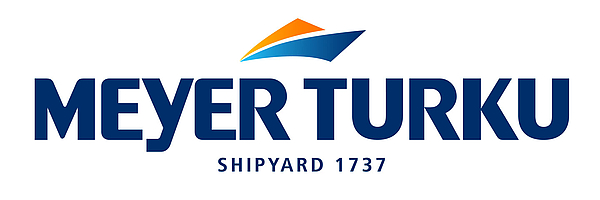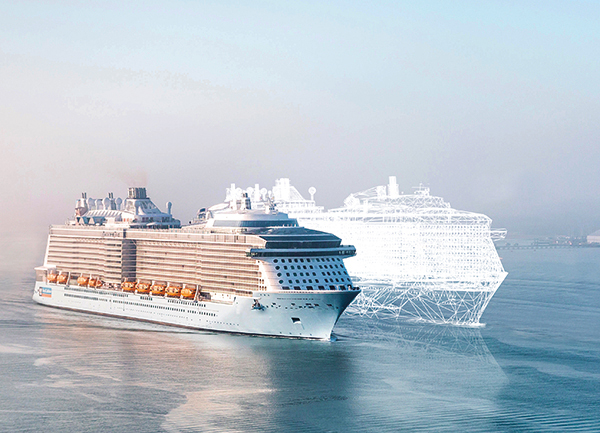
|
PROSTEP helps Meyer Group build cruise ships on a common platformBy Mathias Grau Cruise ships are typically not designed from scratch, but so far there is no systematic reuse of existing design. Now Finnish shipyard Meyer Turku starts to create the first of two ships using a common platform developed together with German counterpart Meyer Werft. German PLM specialist PROSTEP helps Meyer Turku to overcome the challenge of working with different CAD tools in hull design and outfitting. 
Meyer Turku is the biggest yard in Finland and one of the top European manufacturers of large cruise ships, ferries and special ships with up to 225.000 gross tons. The sister yard of Meyer Werft employs 1.550 people directly which are doing all the hull related task on the yard plus coordinating the supplier network. “Project management is one of our core competencies”, explains Tapany Mylly, Communications Manager at Meyer Turku. Some 80 percent of the values comes from 15 to 20 turnkey suppliers and 400 smaller suppliers. "The cruise business is booming with a growing demand for additional ships and new-ones to replace the first generation of cruise ships which is going out of usage", continues Mylly. As the number of shipyards around the world capable of building sophisticated cruise ships is limited, the growing demand puts high pressure on them to raise output and reduce delivery times. Meyer Turku typically works on three ships in parallel and launches one ship per year, now aiming to speed up delivery to a rate of one ship every nine month. Meyer Werft based in Papenburg, Germany, which took over the long established Turku shipyard from STX three years ago, already builds more than two ships per year, as Carsten Lindt, Head of Group Structural Engineering explains. Benefits for the shipping companies When one of Meyer Werft’s mayor customers placed an order of four ships for his different cruising line brands plus options for more, Meyer Weft realized that it would absorb their capacity for several years. The idea was born to distribute the work between Papenburg and Turku and use a common platform as basis. Platform means a common hull structure of same length and size for the submerged part of the ship, using only different shapes for bow and stern to keep brand specific outlines. The internal systems like propulsion systems, energy generators, systems for water treatment etc. in outfitting should stay the same. "Nevertheless, the contours of the ships and everything related to the passenger experience such as public areas will be unique", explains Lindt. It is the first that Meyer Group uses a common platform for various ships. The platform idea fell onto fertile soil as the customer was heading in the same direction: The shipping company wanted to standardize functional areas of their ships, to perform maintenance work more easily and share technical personal between its different ships, yet keeping the different brand styles perceived by their customers. In that sense, the platform approach meant a win-win-situation for shipyard and shipping company. Meyer Werft took care of the technical feasibility of the platform concept, in close contact with the shipping company, and Meyer Turku validated how their ships could be developed and built at their shipyard based on the common platform. Meyer Turku also contributes its knowledge as a pioneer using LNG technology (Liquid Natural Gas) for propulsion of passenger ships to the platform project. Challenge for the engineers in Turku For the engineers in Turku the platform concept means a tremendous challenge. Even though both yards create the same kind of product, they use different processes, methods and design tools for development and manufacturing. Whereas some differences may be due to history, most have a solid technical background. Turku with its large open dock builds the ships full length from tank deck to observation deck. Papenburg on the other side has a fully covered dock capable of containing one complete cruise liner plus a third length of the next ship. Therefore the first step in Papenburg is to build these floatable towers which are later assembled to complete ship length. The different ways of assembling not only influence the size and structure of the building blocks but also the order they are designed. This would make reuse a challenge even if the two yards used the same CAD systems for design, which is not the case. Meyer Werft plans to migrate from its proven CATIA V4 environment to new version V6 which would allow to start with a global hull structure in basic design. Nevertheless, for the actual projects CATIA V4 is still used both for basic and detail design which means that building blocks from Papenburg have to be converted to a different block structure used in Turku. But conversion is much more than adapting the block structure. Finnish engineers are using well known AVEVA Marine for basic and detail design of hull structure and the database-driven tool CADMATIC for outfitting. The question was how CATIA data could be converted to the AVEVA and CADMATIC formats and imported correctly? This is when PROSTEP gets into the game. The specialist for PLM consultancy, systems integration and product data migration has a longstanding reputation in automotive, aerospace, shipbuilding and other industries, but was almost unknown in Finland. “But the quality of communication of PROSTEP was so high that we quickly started to trust in the viability of the project." says Henrik Mantere, team leader Hull Detail Design. Conversion cheaper and more reliable One of the persons who relied from the very beginning on the viability of conversion using PROSTEP technology was Pekka Puranen. Being the CAD Manager of Meyer Turku at that time he compared the costs for conversion with the alternative of using a low-cost engineering service provider in Eastern Europe to recreate the hull structure manually and found out that conversion was not only cheaper, but also promised a much higher level of quality and reliability. Automatic conversion allows a much better control of data quality and a better documentation of the deficiencies, as Puranen explains. As the initial tests finished promising, Meyer Turku engaged PROSTEP to build a dedicated transfer from CATIA to AVEVA Marine. PROSTEP experts first had to adapt the converter to be able to map the V4 building blocks to the Turku block structure. “As the blocks created in Papenburg are slightly different from ours we have to adapt them to our size and height. This is basically a manual process, though PROSTEP has provided some tools to enable splitting and fusing of the geometry and to do most of the renaming of the components automatically”, explains Development Engineer Teemu Mäkinen. "In total, we have to convert some 32 blocks with round about 400.000 single parts." Adding hull detail design data In a second step, PROSTEP created the necessary functionality to allow for conversion of detail design data created in CATIA V4 to the AVEVA model. This enables an incremental refinement process, adding smaller structural parts or creating the openings needed for things like supply pipes for gas, diesel, electricity, clean and waste water. The bigger openings are already done in basic design (structural engineering), as they are relevant for strength calculations. Importing the outfitting openings automatically into the AVEVA Marine hull model saves a lot of time in detail design and avoid errors placing the openings manually. At present, more than 90 percent of the models are already converted and in use for basic design and to prepare classification, as Mäkinen points out. He estimates that 40 to 50 percent of the converted data can be reused exactly as they are. “Furthermore we use data from Papenburg as references for the design of areas which are specific to our ships, instead of starting our work from scratch.” Reuse means time savings of several month for every building block, converting hull design in Turku more to a checking process. 
Reuse of outfitting components “Converting the outfitting components was an even more challenging project”, says Pekka Puranen. Due to the different philosophies of the two CAD systems, PROSTEP could not simply convert the CATIA models but had to extract the component IDs, their position, i.e. start and endpoint etc. and map it to the corresponding ID in the CADMATIC component library, to (re)create the product. Most of these components are unique-ones like engines, gas tanks, etc. but there are also standard parts and other “used IDs” like flanges, pipes or bends that appear thousands of times at different points of the ship. In the first of four conversions covering only the machine room some 4.000 standard parts and 10.000 unique parts with more than 800.000 instances were converted to CADMATIC. This represents a bit more than a third of the whole outfitting equipment, as Puranen explains. The people from engineering service provider ENG’nD Oy in Turku who were in charge of the conversion of the outfitting data initially faced the challenge that the material harmonization in Papenburg and Turku had not been concluded before the first conversion started. “It sometimes required a Sherlock Holmes’ instinct to understand if a component was missing due to a conversion problem or lack of harmonization”, tells Petri Marttinen. “After cleaning of duplicates that we detected in the original model we got much better results.” Conversion not only contributed to a higher data quality, but also helped to identify the components that are really used in the new ship. Speeding up cruise ship delivery At the current state it is difficult to quantify the time savings as the conversion in Outfitting is still underway and the reuse of components depends on the area. “In everything related to the platform the benefits are huge, but we also convert outfitting components of what we call prototype areas and areas in between where we have to decide object by object which can be reused and which not. Here the benefit is not so big”, explains Puranen. In any case, reuse does not only save engineering time but also produces benefits in purchasing, allowing the two shipyards to jointly purchase a higher number of identical components. In addition, hull conversion will enable outfitting and hull detail design departments to take up their work earlier in the process and starting from a higher level of maturity and accuracy. Henrik Mantere and Carsten Lindt are convinced that this will save many engineering hours and speed up delivery of the ships compared to the normal time from the signing of contract to christening which lasts from 2,5 to three years. Furthermore, the conversion project had a big impact on the collaboration of the two shipyards, as Mantere resumes: "During the project we learned about our colleagues from Papenburg, their processes, culture and terminology. We have developed a common understanding which will help us to shape a common future." |
|
| © PROSTEP AG | ALL RIGHTS RESERVED | IMPRESSUM | DATENSCHUTZERKLÄRUNG | HIER KÖNNEN SIE DEN NEWSLETTER ABBESTELLEN. |

